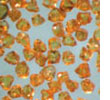WHY USE SUPERABRASIVES?
 Superabrasives are used primarily for grinding “difficult to grind” materials such as Tungsten Carbide,ceramics and various hardened tool steels and alloys.The desirable characteristics of an abrasive include high hardness, abrasion resistance, and resistance to thermal and chemical attack whilst maintaining sharp cutting edges during use, which are amply provided only by Superabrasives. The Diamond and CBN grits used in resin-bonded tools are commonly clad with nickel or copper, which improves both heat dissipation and particle retention within the bond, resulting in enhanced performance and increased tool life. Their application range overlaps for difficult stock removal tasks. The strength and hardness of both Diamond and CBN, so valuable for machining, are a direct consequence of their common crystallographic structure.
Superabrasives are used primarily for grinding “difficult to grind” materials such as Tungsten Carbide,ceramics and various hardened tool steels and alloys.The desirable characteristics of an abrasive include high hardness, abrasion resistance, and resistance to thermal and chemical attack whilst maintaining sharp cutting edges during use, which are amply provided only by Superabrasives. The Diamond and CBN grits used in resin-bonded tools are commonly clad with nickel or copper, which improves both heat dissipation and particle retention within the bond, resulting in enhanced performance and increased tool life. Their application range overlaps for difficult stock removal tasks. The strength and hardness of both Diamond and CBN, so valuable for machining, are a direct consequence of their common crystallographic structure.
ABOUT DIAMONDS:
 Diamonds are the hardest material known to man. Composed of carbon, they are formed at great depths in the earths crust after being subjected to extreme heat & pressure, and are then transported to the earth's surface via volcanic pipes. The average diamond content of a diamond-rich ore is only 1 part in 20 million, making the recovery of this precious mineral an expensive exercise ! Fortunately, man-made (synthetic) diamonds are now being produced to stringently high standards, & whilst they maintain all the qualities of the natural product, they offer a wider variety of grit types, shapes & friabilities to cater for particular tool grinding applications.
Diamonds are the hardest material known to man. Composed of carbon, they are formed at great depths in the earths crust after being subjected to extreme heat & pressure, and are then transported to the earth's surface via volcanic pipes. The average diamond content of a diamond-rich ore is only 1 part in 20 million, making the recovery of this precious mineral an expensive exercise ! Fortunately, man-made (synthetic) diamonds are now being produced to stringently high standards, & whilst they maintain all the qualities of the natural product, they offer a wider variety of grit types, shapes & friabilities to cater for particular tool grinding applications.
ABOUT CUBIC BORON NITRIDE (CBN)
 CBN is the second hardest known material, but occurs only as a synthetic product & has never been found in nature. It is formed under similar conditions as synthetic diamond, the difference being that in CBN some carbon atoms are replaced with boron & nitrogen atoms as nearest neighbours. Because of it's chemical nature, CBN presents no affinity to low carbon steels, & this explains why it is used with great success in the grinding of high speed steels.CBN is harder than conventional abrasives at ambient temperatures, & maintains this hardness over a wide temperature range.
CBN is the second hardest known material, but occurs only as a synthetic product & has never been found in nature. It is formed under similar conditions as synthetic diamond, the difference being that in CBN some carbon atoms are replaced with boron & nitrogen atoms as nearest neighbours. Because of it's chemical nature, CBN presents no affinity to low carbon steels, & this explains why it is used with great success in the grinding of high speed steels.CBN is harder than conventional abrasives at ambient temperatures, & maintains this hardness over a wide temperature range.